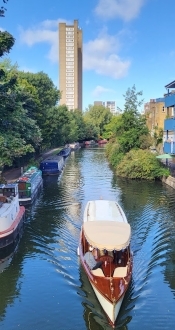Adam Yamey's Blog: YAMEY, page 2
September 19, 2025
Twisted on top of a church in Shropshire
CLEOBURY MORTIMER IS a small town in Shropshire, near to Clee Hill. I could not help noticing that a peculiar church steeple dominates its skyline.
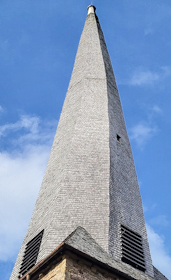
The spire is that of the church of St Mary the Virgin. What makes it distinctive is that it is twisted.
The shingle covered steeple has a timber skeleton that was constructed in the 13th century. Over the centuries, the timbers became damaged by damp, and the spire began to tilt towards the southwest. Furthermore, warping of the woodwork caused it to become twisted. So, the spire not only leans away from being perpendicular but also twists. Fortunately, restorations carried out in 1993 will probably prevent this ancient spire from further deformation.
September 18, 2025
A pillar of great importance in north Wales
THE RUINS OF the Valle Crucis Abbey, formerly a Cistercian establishment, stand a few miles away from the Welsh town of Llangollen. Not far away from these picturesque remains, there is a grassy mound on the top of which there is a stone column. This is the Pillar of Eliseg.
The Pillar was erected in the ninth century by Cyngen ap Cadell (died 855), king of Powys, to commemorate his great-grandfather Elisedd ap Gwylog (died c. 755), also a king of Powys.
The pillar has a lengthy Latin inscription that is now impossible to read, but it was deciphered by the antiquarian Edward Lluyd in 1696. According to the website of CADW, a Welsh governmental organisation that looks after ancient sites, the gist of the inscription is as follows:
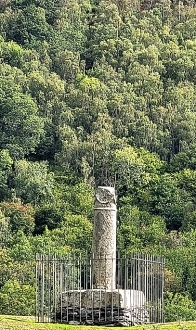
“One phrase includes the names of successive rulers of the kingdom of Powys during the 8th and 9th centuries. Another reveals that the cross was erected by Cyngen in memory of his great-grandfather Eliseg, who was said to have expelled the Anglo-Saxon English from this part of Wales.”
As to its purpose, this source stated:
“It’s thought that the carefully composed inscription, which includes legal terminology, was intended to be read aloud, to be proclaimed to an audience. Could this be where the ancient rulers of Powys were appointed? Is it a victory monument, declaring political ownership of land won back from the English, or vital propaganda at a time when the kingdom was under threat? Or all of these things?”
During the English Civil War, the Parliamentarian soldiers pulled down the pillar, damaging part of it. The remaining upper part of it was re-erected in 1779. And it can be seen easily from the road that runs between the remains of the abbey and the Horseshoe Pass. Eliseg and his descendants would most probably be disappointed to find that to a large extent Wales is now within the control of England.
September 17, 2025
There is more to Wigan than Orwell’s famous Wigan Pier
WHEN WE VISITED Wigan in Lancashire in 2022, we saw hoardings that advertised the forthcoming opening of an “artisan deli”, and wondered what George Orwell would have made of it.
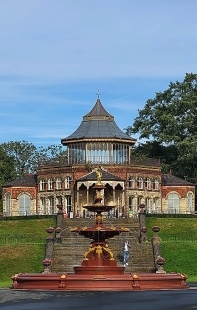
We returned to Wigan Pier in September 2025, and headed for the site of the proposed artisan deli. However, it has not been built and the signs advertising the plans to build it are no longer to be seen. The area around the Pier looks similar to what it did in 2022. The warehouses that were to have been redeveloped stand empty. Peering through their windows all that could be seen were huge, dusty empty spaces.
During our second visit to Wigan, we took a stroll in the town’s Mesnes Park. This beautifully maintained park was laid out in 1878 on glebe land (terrain set aside to provide income and support for a parish priest). Apart from a lovely pond, lawns, and carefully tended flower beds, the park contains several interesting features. One of these is the octagonal pavilion built in 1880. Now containing a café, it stants on a raised mound, and can be approached by elegant stone staircases. In fron of its main entrance, there is a statue of a soldier, which is part of a memorial to those men of Wigan who fought in the 2nd Anglo-Boer war (1899-1902). And a few steps down from this, there is the elegant cast-iron Coalbrookdale Fountain. This is a replica of one which stood in the park until 1921. Near the pavilion, there is a 10-sided Victorian bandstand.
Between the Pavilion and the main entrance to the park, there is a statue of a seated man. It depicts the Conservative politician Sir Francis Sharp Powell (1827-1911). He held a seat in the House of Commons from 1863 until 1910. He was born in Wigan, but represented several different constituencies during his long parliamentary career. The bronze statue in the park was created by Ernest George Gillick (1874-1951), and erected in Wigan in 1910.
Just over two miles northeast of central Wigan, lies Haigh Hall (built between 1827 and 1840), which was undergoing restoration in 2025. It is surrounded by Haigh Woodland Park, which is a vast parkland area containing a variety of leisure facilities including eateries, adventure playgrounds, a golf course, a mini-golf course, and a fine walled garden. It is hoped that when the restoration of the Hall is completed in 2028, it will provide opportunities for a whole range of activities for visitors.
Our second visit to Wigan has shown us that there is much more to the place than Orwell’s famous Wigan Pier.
September 16, 2025
Birds with two heads in Lancashire
I HAVE LONG been fascinated by the double-headed eagle (‘DHE’). The earliest evidence of its use as a symbol is on Mesopotamian seal rings made as long ago as c3000 BC. Since then, it has been used by the Seljuk Turks, the Byzantine Empire, the kingdom of Mysore, Russia, Austro-Hungary, Serbia, Montenegro, Albania, and many other peoples.
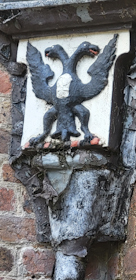
In England, aristocratic families such as the Killigrews and the Godolphins in Cornwall have incorporated it in their coats-of-arms. Today, we visited Rufford Old Hall in Lancashire. It was once the seat of the Hesketh family. And their original coat-of-arms included the DHE. This two headed bird can be seen in many places on the building.
For those less interested in the DHE than me, the main attraction of the place is the 16th century Hall with its hammer beam ceiling and its amazing timber screen.
When we decided to visit Rufford Old Hall today, I had no idea that I would be seeing yet another British family’s use of the DHE. I have no idea what if anything caused these families to incorporate this creature in their crests. It is far less used in Englush heraldry than other creatures such as, for example, the lion, the eagle, the unicorn, and the griffin.
September 15, 2025
A mill and a bottle in a village in Lancashire
PARBOLD IS A village about 16 miles northeast of the centre of Liverpool. In 1742, the Douglas Navigation, a canal that links Wigan and Liverpool, became operational. It carried stone, coal, and other goods to Liverpool from where they could be shipped to Dublin. The canal passes through the centre of Parbold, and led to the mining of coal in the area. In turn, this led to an increase in the village’s population. With the arrival of the railway in 1855, Parbold became more easily accessible to Manchester and Wigan. This resulted in wealthy inhabitants of these towns coming to live in Parbold. And in the 1960s and 1970s, new housing estates were built in the area. Despite this, Parbold remains a charming place to visit.
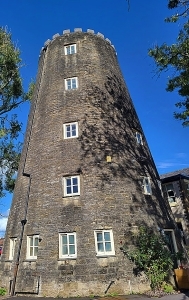 Parbold mill
Parbold millParbold Hall, which was built in the 1750s, housed a Benedictine School. This institution was the forerunner of the leading Roman Catholic Ampleforth School, which opened in North Yorkshire in 1802. Soon after that, the boys studying at Parbold Hall were moved to Ampleforth, and the Parbold school was closed. Currently, the hall is privately owned, and let out for weddings and holiday accommodation.
One of Parbold’s main attractions is the tall, conical tower that was once a windmill. It stands next to the canal, and replaced a water mill that no longer exists. A website published by West Lancashire Borough Council related that the tall mill:
“… replaced the water cornmill which once stood near the Douglas bridge in Alder Lane. The windmill in its turn was superseded in the middle on the 18th century by the present mill which was originally worked by a steam engine and produced compound cattle foods until its closure in 1985.”
Part of the former mill is now an art gallery. Next to it, there is a pub appropriately named The Windmill. It opened in 1794 to serve both the growing traffic along the newly opened sections of the Leeds to Liverpool Canal and the farmers delivering grain to the neighbouring windmill. It soon became a meeting place for locals. Today, it incorporates a restaurant in addition to the usual bars.
The most interesting sight in Parbold is on a hill overlooking the village and the fields around it. Looking like the top third of a wine bottle, it is a stone monument known as both the Reform Pillar and the Parbold Bottle. It was erected by local worthies to replace another structure, which commemorated the passing of The Reform Act in 1832. The Act made great changes in the electoral system by changing constituency boundaries; creating new constituencies in areas that had been hitherto unrepresented in Parliament; and extending the franchise, giving the vote to all men owning houses over £10 in rateable value. It was the beginning of the path that led eventually to universal suffrage in Great Britain. As a result of the Act, Lancashire gained 11 new Members of Parliament. The bottle-shaped monument was badly damaged by a gale in 1942, but was restored in 1958. A short path leads from a busy main road to the Bottle from which lovely views can be obtained. The monument itself, although interesting, is not a thing of beauty.
Today, Parbold is mainly residential and a popular place for those wishing to walk along the canal or to go fishing. And apart from The Windmill pub, there are several other places where refreshment can be obtained.
September 14, 2025
The good life
September 13, 2025
One pub in London split between two buildings
EVERY PUB HAS its own characteristics. Some of these establishments are more distinctive than others. The Ship and Shovell pub in Craven Passage near to Charing Cross station distinguishes itself from all other London pubs by being housed in two separate buildings separated by a public thoroughfare.
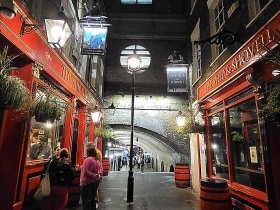
The two houses that house the pub’s two halves were built in the early 1730s, but have been modified since then. Until 1998, one building was The Ship pub and the other, facing it, was a separate establishment, The Shovell pub. Shovell either refers to coal workers who laboured in the area, or to Admiral of the Fleet Sir Cloudesley Shovell (c1650 –1707), who died at sea near the Isles of Scilly. In 1998, the two pubs were united when their two separate underground cellars were connected to each other with a common kitchen.
So, after 1998, what had once been two pubs became one but housed in two separate buildings. As a sign outside one of the parts of the pub reads, The Ship and Shovell is:
“The only London pub in two halves”
When I next visit it, I will have half a pint in one half and another half in the other half.
September 12, 2025
Drafting an introduction to a book about England – your comments, please!
I am writing a book about visiting places in England. Here is a part of the introduction to the book. As it is only a draft, please feel free to comment on it, and also to let me know whether it would entice you to want to read further. What I have written is below this photograph.
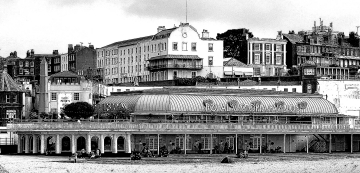
This is what I have written:
There are plenty of remarkable places in England. For as the author Daniel Defoe (1660-1731) wrote in his “A Tour Through the Whole Island of Great Britain”:
“In travelling thro’ England, a luxuriance of objects presents itself to our view: Where-ever we come, and which way soever we look, we see something new, something significant, something well worth the travellers stay, and the writer’s care…”
What Defoe wrote so many years ago in the mid-1720s, is still true today. My book is about exploring a selection of places in England, especially many of them that are not on tourists’ usual itineraries. I have written about locations, which have intrigued me. Although some of them will not be familiar to most readers, I hope they will be found to be interesting. I have visited most of them since the onset of the covid19 pandemic in early 2020.
For about 10 years prior to 2020, we did not own a car. When the covid19 lockdown regulations began to ease a little in the UK, and greater freedom of movement was permitted despite the high prevalence of the infectious disease, we felt the need to roam around – to ‘escape’ from our neighbourhood. However, we had become uneasy about using public transport. So, in May 2020, when car showrooms reopened, we acquired a car, and began making day trips into the countryside. At that time, staying in hotels etc was not allowed. After a few months, it became possible to stay in hotels, guest houses, and so on.
Before the onset of the pandemic, we had, like so many others, chosen to holiday out of England, believing places abroad to be more interesting than our own country. During the pandemic, we were compelled to travel within its confines. And having travelled extensively in England during the last 5 years, we have discovered that the country is as least as interesting as many lands across the sea on the mainland of Europe. This book gives an account of some of the places we have been to in England since May 2020, and a few that we had already seen before the pandemic.
September 11, 2025
You too can write a book that becomes a bestseller
MANY THOUSANDS OF authors aspire to ‘make their name’ by publishing their writing. Most of these people hope to follow in the footsteps of, say JK Rowling, and to achieve fame and become a bestselling author. This hope is exploited ruthlessly on social media, especially, so I have noticed, on Facebook and X (formerly ‘Twitter’).

Every day, I notice a steady stream of advertisements promising to convert your piece of writing into a bestseller. Some ads offer to convert your manuscript into a book that looks as if it has been produced by a recognised commercial publishing house. Other, provide editing and mentoring services. Yet more of them, promise to promote your book on social media. Some will guide you as to how to make your book more prominent on Internet search engines. And others will review your book any number of times. There are even websites that will write the text of your book using AI. All these services naturally attract fees, and these can in some cases be quite hefty. If despite using these miraculous sounding services, your book neither sells well nor achieves great acclaim, you might be considerably out of pocket.
The problem is that very few of the myriad books written have either any outstanding literary merits or appealing features. The services offered in the ads offer profits and huge readerships on the horizon. But will they materialize, or will they remain mirages that fade away after you have parted with your money? I have never used any of the services that I have seen advertised. I wonder whether they would be honest enough to say that despite their best efforts, the submitted work is likely to be a failure, or do they not care.
OR, am I just a skeptic at heart?
September 10, 2025
Feeding the pigeons in Jaipur (Rajasthan)
Here is a brief excerpt from my book “88 DAYS IN INDIA: A JOURNEY OF MEMORY AND DISCOVERY”, In this sample, I am writing about pigeons in Jaipur (Rajasthan) and elsewhere:
“While we were being driven around the city, we passed areas where food and
water were being distributed to some of the city’s many pigeons. The provision
of food for pigeons (as well as street dogs and other animals) is commonly
found in many other cities and villages we have visited in India. In Jaipur, we
saw vendors selling passersby seeds for the birds. Earlier in 2024, when we
were in Istanbul, we saw similar vendors at an area (near the Spice Bazaar)
where pigeons were plentiful. As a child during the early 1960s, my parents
used to buy me cones full of corn for feeding the pigeons in the Piazza Signoria
in Florence (Italy). Long ago, I remember pigeon feed being sold in London’s
Trafalgar Square. However, now Londoners regard pigeons as pests, which
should not be fed. One of London’s former Mayors, Ken Livingstone, who
ended selling of pigeon food in the square in 2001, called pigeons: “rats with
wings”.
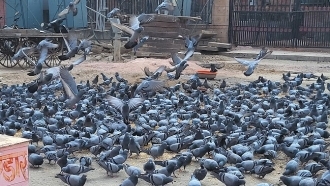
Although feeding pigeons has caused India’s population of these
creatures to increase to alarmingly high levels, Shreemoyee Chakraborty
(quoted in an article published by theprint.in in November 2024) noted:
“In India feeding pigeons is not just a habit; it has a religious and
cultural significance as well.”
In an online article about Vastu Shastra (published on vastulabh.com), it was
pointed out that:
“Pigeons have long been associated with Goddess Lakshmi, the deity
of wealth and prosperity. According to Vastu Shastra, pigeons are
believed to bring positive energy and good fortune into the home.
However, there are differing opinions and specific guidelines on how to
interpret their presence.”
So, it is likely that feeding these winged creatures in India has a good chance of
continuing despite the occasional attempts of some municipal authorities,
including in Jaipur, to reduce their population.“
If you wish to purchase a copy of this book, hasten to Amazon’s website:

